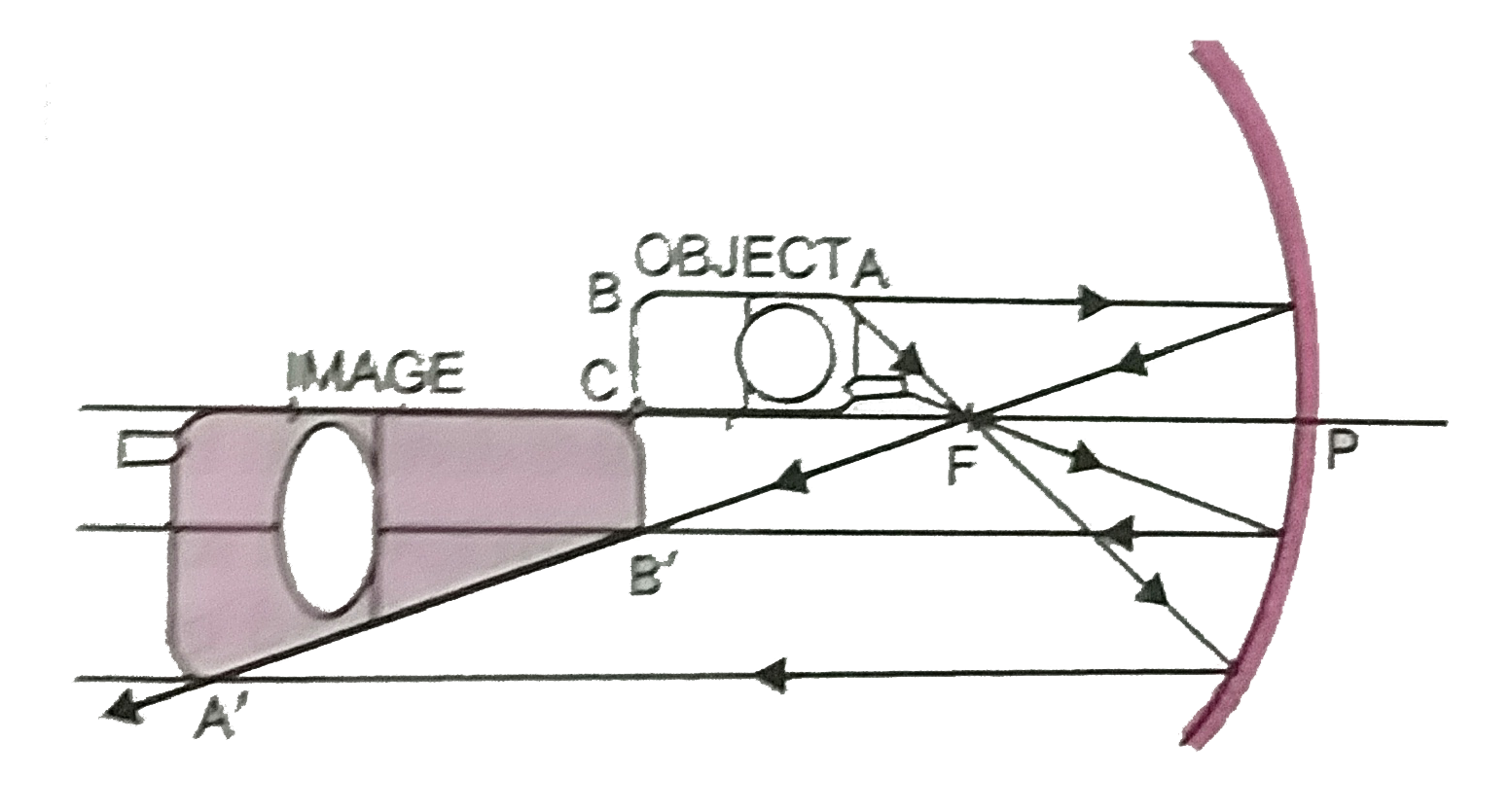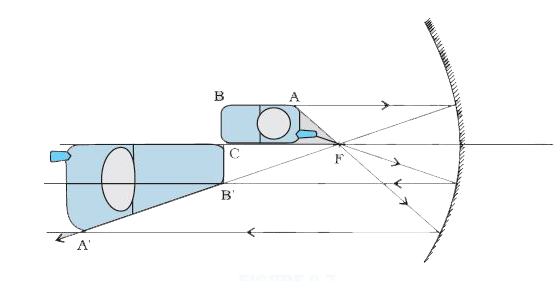(a) A mobile phone lies along the principal axis of a concave mirror. Show, with the help of a suitable diagram, the formation of its image. Explain why magnification is not uniform ?
(b) Suppose the lower half of the concave mirror's reflecting surface is covered with an opaque material. What effect this will have on the image of the object ? Explain. Solution in Kannada

(b) Only intensity wil reduce.
Topper's Solved these Questions
- BOOK - OSWAAL PUBLICATIONCHAPTER - RAY OPTICS AND OPTICAL INSTRUMENTSEXERCISE - TOPIC-1(SHORT ANSWER TYPE QUESTIONS-2)6videos
RAY OPTICS AND OPTICAL INSTRUMENTS
- BOOK - OSWAAL PUBLICATIONCHAPTER - RAY OPTICS AND OPTICAL INSTRUMENTSEXERCISE - TOPIC-1(LONG ANSWER TYPE QUESTIONS)7videos
RAY OPTICS AND OPTICAL INSTRUMENTS
- BOOK - OSWAAL PUBLICATIONCHAPTER - RAY OPTICS AND OPTICAL INSTRUMENTSEXERCISE - TOPIC-3(Numerical Problems)3videos
RAY OPTICS AND OPTICAL INSTRUMENTS
- BOOK - OSWAAL PUBLICATIONCHAPTER - NUCLEIEXERCISE - TOPIC -2 (Numerical Problems)3videos
NUCLEI
- BOOK - OSWAAL PUBLICATIONCHAPTER - Sample Paper 1EXERCISE - Exercise36videos
Sample Paper 1
Similar Questions
Derive the relation f=R/2 in the case of a concave mirror.
01:10View SolutionDerive the expression for refractive index of the material of the prism in terms of angle of the prism and angle of minimum deviation.
05:49View SolutionThe total magnification produced by a compound microscope is 20. The magnification produced by the eye piece is 5. The microscope is focussed on a certain object. The distance between the objective and eyepiece is observed to be 14cm.
If the least distance of distinct vision is 20cm, calculate the focal length of the objective and the eye piece.View SolutionThe half life of 38Sr90 isotope is 28 years. What is the rate of disintegration of 15 mg of this isotope? (Given Avogadro No =6.023×1023)
05:49View SolutionCharges of 10μC and 15μC are separated by a certain distance. Which charge repels the other with a greater force?
01:10View SolutionSuppose that the lower half of a concave mirror's reflecting surface is covered with an opaque non-reflecting material. What effect will this have on the image of an object placed in front of the mirror ?
02:05View SolutionA mobile phone lies along the principal axis of a concave mirror as shown in Fig. Show by suitable diagram, the formation of its image. Explain why the magnification is not uniform, and distortion will occur depending on the location of the mobile with respect to the mirror.
 03:28View Solution
03:28View SolutionA mobile phone lies along the principal axis of a concave mirror longitudinaly. Explain why the magnification is not uniform.
07:25View SolutionA mobile phone lies along the principal axis of a concave mirror as shown in Fig. Show by suitable diagram, the formation of its image. Explain why the magnification is not uniform, and distortion will occur depending on the location of the mobile with respect to the mirror.
 07:32View Solution
07:32View SolutionSuppose that the lower half of a concave mirror's reflecting surface is covered with an opaque non-reflecting material. What effect will this have on the image of an object placed in front of the mirror ?
02:53View SolutionSuppose that the lower half of the concave mirror's reflecting surface is covered with an opaque (non-reflective ) material. What effect will the have on the image of an object placed in front of the mirror ?
03:30View SolutionA mobile phone lies along the principal axis of a concave mirror, as shown in figure. Show by suitable diagram, the formation of its image. Explain why the magnification is not uniform. Will the distortion of image depend on the location of the phone with respect to the mirror ?
View SolutionA mobile phone lies along the principal axis of a concave mirror, as shown in Fig. 9.7. Show by suitable diagram, the formation of its image. Explain why the magnification is not uniform. Will the distortion of image depend on the location of the phone with respect to the mirror?
 03:49View Solution
03:49View SolutionA mobile phone lies along the principal axis of a concave mirror, as shown in Fig. 9.7. Show by suitable diagram, the formation of its image. Explain why the magnification is not uniform. Will the distortion of image depend on the location of the phone with respect to the mirror?
07:25View SolutionSuppose that the lower half of a concave mirror's reflecting surface is covered with an opaque non-reflecting material. What effect will this have on the image of an object placed in front of the mirror ?
View Solution

